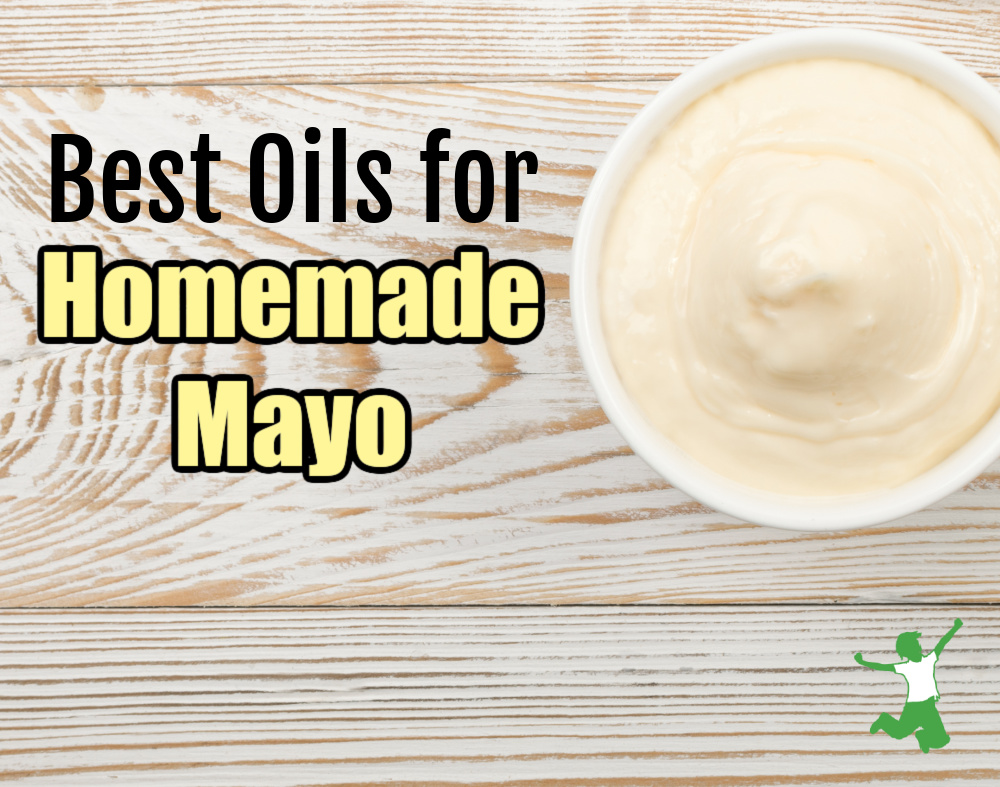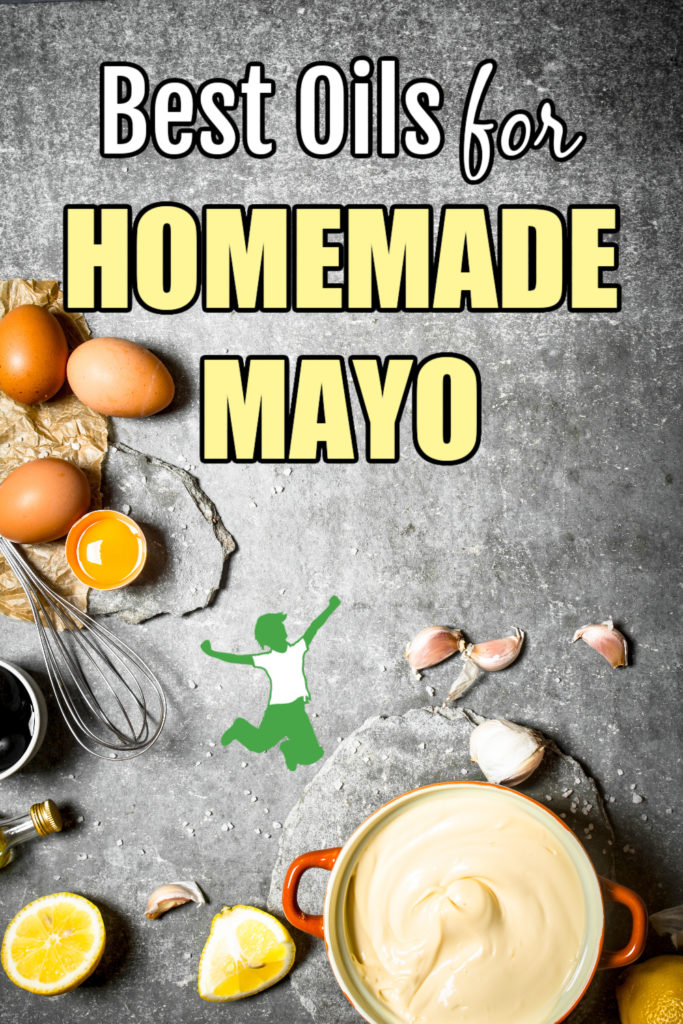Table of Contents[Hide][Show]
Which oils to consider for making nourishing homemade mayonnaise and which is best based on taste, consistency and healthy fat content.

Life without mayonnaise? Perish the thought! It is an essential condiment in the kitchen and learning how to make healthy mayo yourself is so simple and easy that once you give it a go, you won’t be settling for anything from the store – including the healthfood store – ever again!
Even homemade eggless mayo is super simple to whip up yourself. Psst. Don’t use aquafaba though!
The smooth, creamy texture and sheer elegance that quality mayo imparts to sandwiches, salads, and sauces are certainly unrivaled at least in American cuisine.
Never does the thought cross my mind to “go light on the mayo”. If I am feeling like a huge dollop or two, I feel free to indulge myself given that the mayo I insist on using is of superior freshness and quality and made with health-boosting oils and liquid whey for additional digestive enzymes and even probiotics.
Given that the fats used in the mayo are the most critical ingredient, which oils are the best ones to select?
Sunflower or Sesame?
I tell folks that when making mayo for the first time, use sunflower seed oil as this will give the closest consistency and taste to store mayo.
However, sunflower oil is a high omega-6 oil. This is fine if one follows whole food, traditionally based diet where the omega 3 to omega 6 fatty acid ratio is roughly between 1:1 and 1:4.
If one is still in the process of transitioning off processed foods, however, a lower omega-6 oil is probably a better choice. This is because processed foods are loaded with rancid omega-6 oils. Too much in your diet encourages inflammation.
Note that including even a few processed foods in the diet can skew that omega-3 to omega-6 balance in a hurry!
If you are concerned about your omega-6 intake, unrefined sesame oil is a good choice for mayo as it is higher in oleic acid (monounsaturated, omega 9 fat) and lower in omega-6 fats (polyunsaturated) than sunflower oil. Oleic acid is the healthy fat found in great quantity in avocados and olive oil.
Olive Oil
If oleic acid is so fantastic, then why not just use extra virgin olive oil for mayo?
While this can be a good choice for some, many folks find the flavor of olive oil mayonnaise too strong.
Using half olive oil and half sesame oil is an option for a milder taste which is still high in oleic acid.
In addition, some folks find that olive oil really packs the weight.
Oleic acid is a long-chain fatty acid and is more likely to contribute to the buildup of body fat than shorter chain fatty acids found in coconut oil or ghee. Let’s talk about both of those next.
Coconut Oil or Ghee
What about ghee or coconut oil for mayonnaise?
I’ve made mayo with ghee before and it turns out absolutely fabulous. The one drawback is that the mayo turns out too rich in my opinion. It also hardens in the refrigerator and loses consistency when brought to room temperature.
Since I like to use a lot of mayo, using all ghee doesn’t really work for me in most situations. However, half ghee and half sesame oil can work to lighten up the richness factor a bit.
A similar problem happens with coconut oil mayo. It hardens in the fridge and can’t be used quickly for chicken salad and other dishes.
If you choose to make coconut oil mayonnaise, be sure to use expeller-pressed, which is flavorless. Virgin coconut oil results in a coconut flavored mayo, which some people do not enjoy.
Blended Oils
Another option for homemade mayo is to blend fats together to achieve a good taste and consistency.
One I’ve used in the past is 1/2 sunflower or sesame oil and 1/2 expeller pressed coconut oil.
Since coconut oil goes very firm below 76 F/24 C, using half expeller-pressed coconut oil produces a mayo that is very thick and scoopable even after refrigeration.
Another option suggested by the Weston Price Foundation is what’s known as “Mary’s Blend” after the late Dr. Mary Enig, a PhD in lipids. She suggested a blend of 1/3 olive oil, 1/3 sesame oil, and 1/3 coconut oil.
Avocado Oil. My Favorite Fat for Mayo
As you can see, there are numerous options for healthy fats for making mayo.
Judging based on taste, nourishing lipid content, and consistency (both at room temperature and refrigerated), my favorite is avocado oil.
It is mild tasting, has a fatty acid profile similar to olive oil, and the mayo stays creamy in the fridge.
If you must buy, there are a couple of brands now available that are acceptable. This is the brand I use in a pinch. The only downside is that it does not use raw egg yolks, and it is a bit pricey.
Be sure to check my Resources page for a list of brands I trust that supply quality oils for all your mayo-making endeavors!
Here’s a short video of what avocado oil mayo looks like after I made a batch.









I make a pint of mayo every week or two weeks for 10 years now. It is absolutely delicious. I use only safflower oil in mine. pasteurized egg yolk, garlic, vinegar and dash of lemon juice at the end. Keeps in fridge for a month if it lasts that long. I use a lot, potato salad, macaroni salad waldorf salad and bang bang chicken. couldn’t live without it.
I recommend using a different oil. https://www.thehealthyhomeeconomist.com/safflower-oil/
How long will your avocado oil mayo last in the fridge?
If you use the whey to lightly culture it, about 3-4 weeks.
All seed oils are terrible !
They are highly processed, toxic, and they oxidize.
Instead a good quality olive oil or avocado oil would be fantastic.
Thank you for the guidance, I haven’t been successful making a mayonnaise so far, I realize now that my technique was wrong. I was wondering, I haven’t seen a soybean oil option, but that’s okay, I have reservations about the plant estrogen and estrogen analogs in it, there is evidence that it contributes to the development of man-boobs and obesity in adolescent and even senior citizen males. There was an article a few years ago in Men’s Health magazine about a senior citizen males who was a combat veteran, a man’s man, so to speak, who was drinking one of those protein supplement creamy soy based liquid products, and he developed man-boobs, crying spells(he had very crying in his whole adult life) and even a high squeaky voice. His doctor got him off the Ensure and put him on a whey protein drink instead and his problems went away. Soy products are ever present in our food supply because our Big Agriculture lobby pushed it so hard. But what we put in our mouths is OUR business, not Big Ag or their servants, the USDA and the FDA. And don’t even get me started on transfats, I’m a retired research chemist and I know their dirty secrets. That’s another posting for another day.
Soybean oil is not a healthy oil for making mayo.
I read about a great mayo substitute….use cashew or almond milk yogurt and add a little mustard. It works great in tuna/chicken/potato salads, as a dipping sauce for everything…fruit included, and it has probiotics and no eggs or oil. Eat as much as you want guilt-free and anti-inflammatory .
I was using primal kitchen mayo and lately it’s been separating and tasting gritty almost. What other brands would you recommend?
Im not really into making my own. It feels that I make a batch to use w one can of tuna and then stick it in the fridge and then I have to throw it out.
I was coming here to comment this, they changed their formula, and it got an awful undertaste, like old horseradish. I was so disappointed, because I couldn’t find anything without soy or canola oils, and the vegan ones are rank. I’m so glad I am not the only one who noticed. And, just because it took me a hot minute, we actually bought a few different packaging and sizes from different places, I was so determined to fine one I could eat, and so sad to live without for several months until I found Chosen Foods, and now I won’t be buying any anymore, as making my own works!!! 🙂 Just need to keep a good avocado oil on hand. I’m going to try sesame seed oil, too. 🙂
I personally did NOT like the taste of macadamia when I used it to make mayo…. I used organic, liquid, refined coconut oil which does not solidify your mayo in the fridge.
What about macadamia nut oil? I’ve used it before and really enjoyed it.
Yes, that is fine … but it is soooo expensive. I didn’t think it was really that practical for mayo.
I don’t see your recipe for homemade avocado mayo?
Hi Elaine, here it is. https://www.thehealthyhomeeconomist.com/real-people-making-real-food-in-real/
I don’t care for Avocado Oil Mayo ~ not sure what kind you’re using, but if one were to use the most pure, organic and 100% AvoOil (as I do) then your mayo would be green. It tastes fine, just strange as mayo has always been white! Here is my favorite combo: 3/4 c Fractionated Coconut Oil with 1/4 cup EVOO ~ this is delicious, creamy and holds up well. :0)
Thanks for sharing! My issue is with fractionated coconut oil, which is highly processed. https://www.thehealthyhomeeconomist.com/mct-oil-the-coconut-oil-dregs/